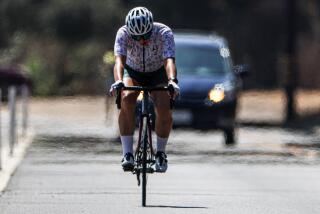Demand for Electric Power Intensifies as Region Bakes
- Share via
The late August heat wave extended into September on Tuesday, setting yet another in a string of records for energy usage.
The Los Angeles Department of Water and Power said customers cranked up their air conditioners to the tune of 5,650 megawatts, well above the normal peak demand of 4,500 megawatts. There were reports of minor, scattered outages, DWP spokeswoman Darlene Battle said.
Although the DWP was asking customers to conserve energy, the agency had more than enough power to meet the demand, Battle said.
The only thing that might have made Valley residents feel better about suffering through another day of oppressive heat was the fact that people at the beaches had it almost as bad.
Winds blowing offshore meant that even places such as Los Angeles International Airport registered temperatures well into the 90s. Of course, the Valley had it worse.
Chatsworth reported a high of 110 on Tuesday, while Van Nuys hit 107 and Northridge and Burbank came in at 105, according to WeatherData, which supplies forecasts for the Times. In contrast, Lancaster reported a relatively balmy 95.
Today is likely to produce more of the same, with the upper-level, high-pressure system remaining in control and offshore winds keeping the region baking in the continuing heat wave.
By Thursday, temperatures should drop slightly, as the high-pressure ridge weakens just enough to bring temperatures down into the upper 90s for most Valley areas, said WeatherData’s Jeff House.
The weekend should see better weather still, as Friday cools more and Saturday brings Southern California back into the normal temperature range, meaning the low 90s in the Valley.
“You guys are in the heat for a while,” House said. “You’ll have to wait for the cool autumn weather, but that doesn’t arrive so soon in Southern California.
“I think people see the calendar go to September and are waiting for these cooler temperatures, but it doesn’t happen that way in Southern California, especially in the valleys.”
More to Read
Sign up for Essential California
The most important California stories and recommendations in your inbox every morning.
You may occasionally receive promotional content from the Los Angeles Times.










